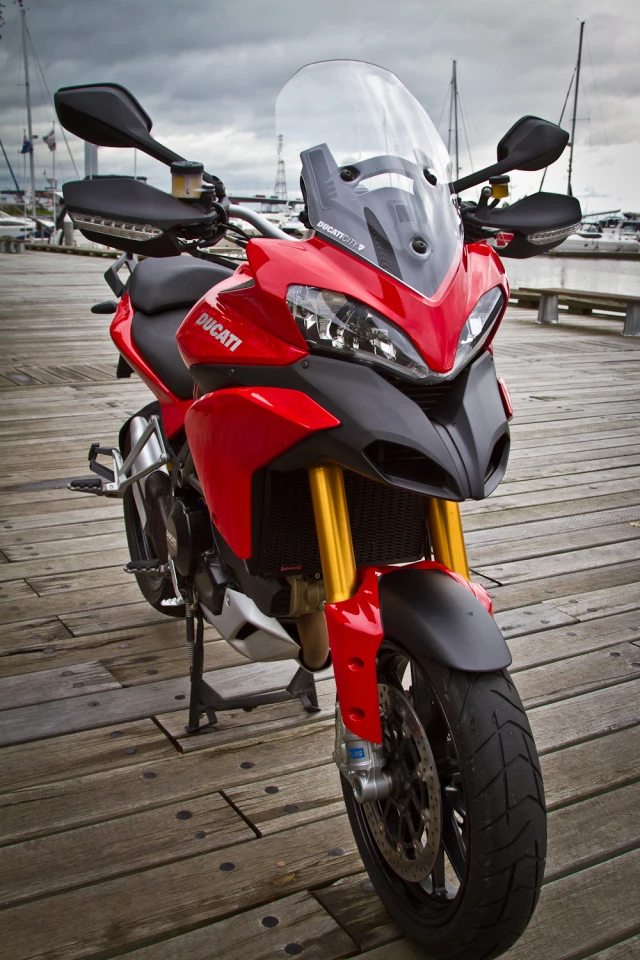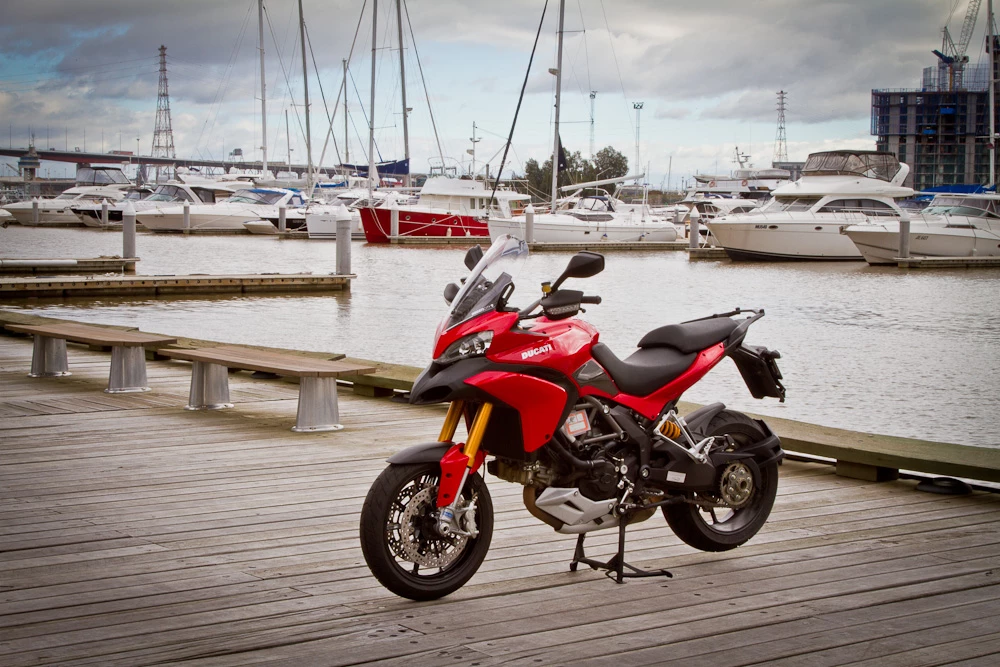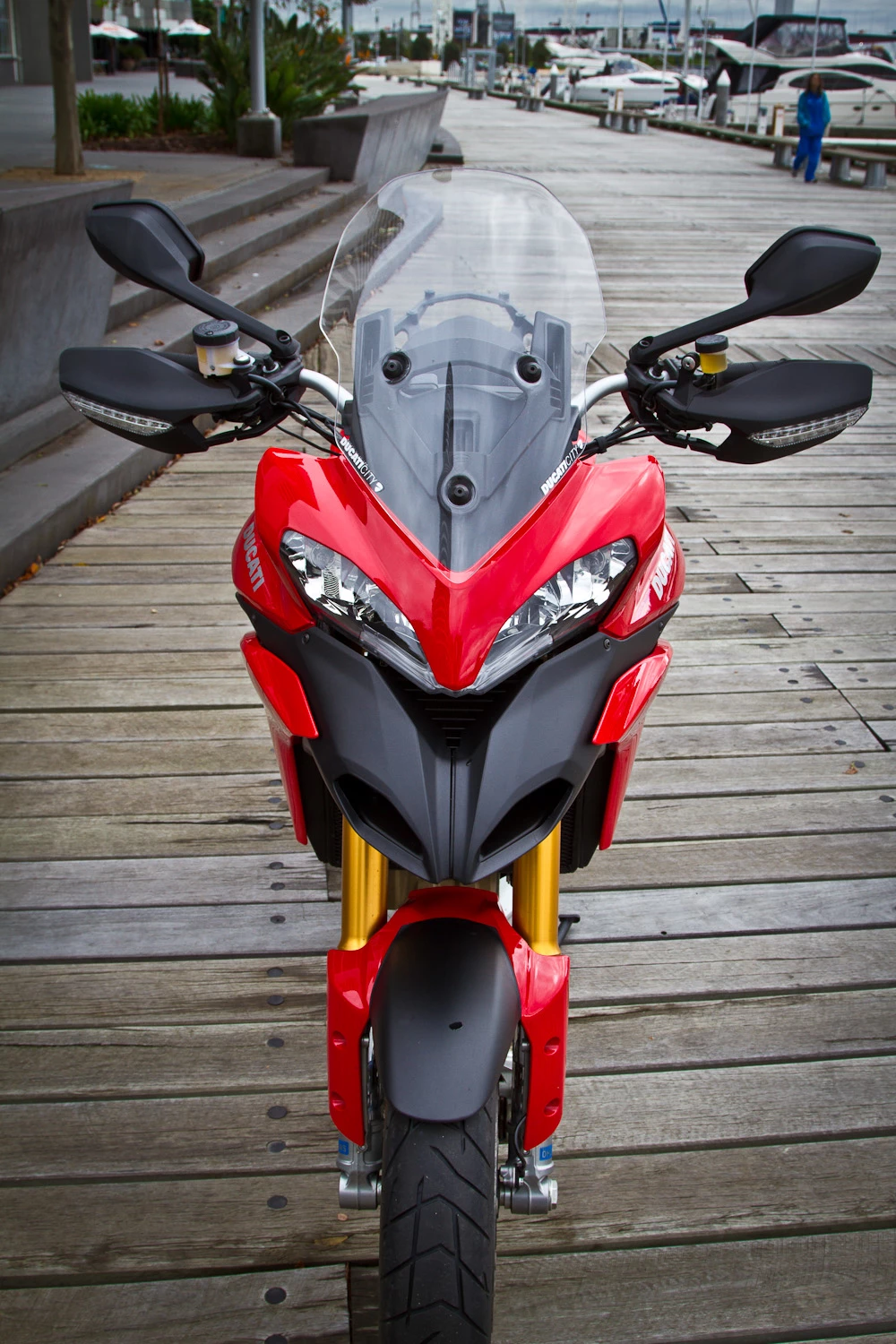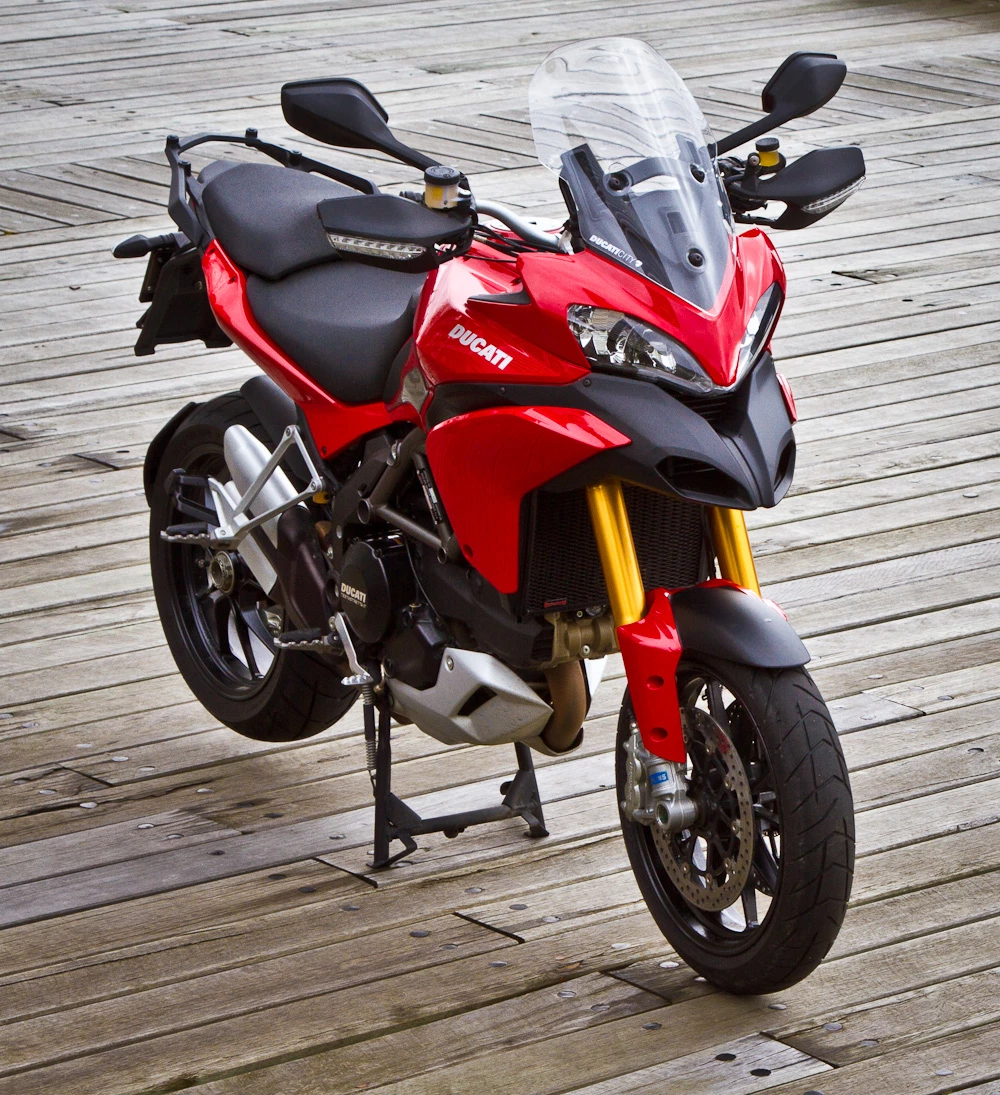We've been looking forward to this ride for a looooong time; this is a truly significant motorcycle. Ducati has stamped its authority on the Adventure bike segment in the only way it knows how. The new Multistrada 1200 S is vastly more powerful and exciting than anything else in the segment. In fact, it's more powerful and exciting than an awful lot of pure sportsbikes. What's more, with its traction control, ABS, fly-by-wire throttle mapping and electronic suspension adjustments it boasts the most technologically advanced computer system we've ever seen on a streetbike - while still being marvellously simple to ride.
The big bore "Adventure" touring segment is starting to look pretty crowded at the moment - you've got grandpa Beemer, the big KTM, the viciously ugly but practical V-Strom, Yamaha's proto-beemer Super Tenere, Triumph's Tiger, Guzzi's Stelvio ... each with its own mix of off-road capability versus on-road touring practicality.
Ducati's Multistrada has always sat just outside this category, somewhere on the fringe. Chunky-looking, comfy, quick and almost entirely road focused, the old Multistrada really sat better under the naked or sports touring umbrellas. You'd probably do just about as well in the dirt on, say, an FZ1 - and you'd be substantially less worried about scratching the paint.
The new Multistrada 1200 S has paint just as shiny as the old model, but it's a complete rethink of the Multistrada concept from the engine out. The old bike made a useful, if not sprightly, 92 horsepower from its 1100cc, 2 valves per cylinder L-twin engine. The new one rips tarmac with a gigantic 150 horsepower out of a lightly revised 1198 superbike engine with 4 vales per head.
This figure alone tells you where the MTS sits in its class - it's the bully. Half as much power again as a KTM 990 Adventure, and a healthy 40 ponies over the much heavier BMW. It's an absolute monster on the road, revving like crazy and throwing the front wheel skyward every time you jerk the throttle in the lower three gears.

With its powerful, radial Brembo brakes, Ohlins TTX suspension and relatively light weight at 189kg (420lbs), the Multistrada has taken a gigantic leap forward from its predecessor as a roadbike. In fact, it steers so fast and true in the twisties, and explodes so violently out of apexes, that there's very few bikes on the road that will get away from one if it's well ridden. If it wasn't for some minor ground clearance issues, this would make a pretty convincing sportsbike - and it'll take a heck of a rider to find its limits at the racetrack.
But 150 horsepower is a recipe for disaster in the dirt, and the firm suspension that you need for maximum traction on a smooth twisty road would rattle your teeth out on a bumpy dirt road - and this is where the true genius of the 1200 S comes into play.
Riding mode switches have been popping up on fuel injected motorcycles since the 2007 Suzuki GSX-R1000, as manufacturers realized that the stratospheric horsepower of today's performance bikes is simply too much for some riders under some conditions. Early efforts like the 07 Gixxer simply offered different fuel maps, restricting the bike to lower horsepower.
The Multistrada takes the mode concept to unprecedented levels, and allows Ducati to fit an incredibly broad electronics package into a bike that's still dead simple to ride.

The MTS mode switch (built into the indicator cancel button) toggles between 4 riding modes: Sports, Touring, Urban and Enduro. Each mode has a custom (and customisable) setup that includes peak engine output, throttle response, intervention level from the Ducati Traction Control system, ABS settings, and even electronic suspension setup.
In Sports mode, for example, the suspension is set quite firm, with added preload, compression and rebound damping at both ends. The power output is set to the full 150 horses, and the throttle mapping is similar to the track mode on Aprilia and BMW sportsbikes - that is, power comes on strong and immediately with minor throttle movements. Traction control is set to allow a reasonable degree of powersliding out of corners. It's a tough mode to ride in - your throttle control has to be godlike to avoid jerky spikes of power, so you need to be concentrating 110% to get the most out of the bike.
Touring mode is a softened version of Sports mode - you get all 150 horses, but the throttle mapping is backed off to a softer delivery. This means you have to twist the throttle a little further to get big power down, but it's much smoother, less aggressive and easier to ride hard. Traction control is brought up to allow less wheelspin, and the suspension is softened off so that your freeway miles are more comfortable.

Urban mode cuts peak power to 100 horses, and retains Touring mode's gentler throttle response. Traction control is maxed out, and the suspension setup feels similar to Touring mode, or perhaps a little more comfort focused. One-hundred horsepower sounds like a cruel neutering of the 1200cc powerplant, but in all honesty Urban mode still feels brutally powerful when you twist the throttle round far enough. The bike still leaps forward, wheeling with ease and obliterating traffic and speed limits.
Enduro mode sets the suspension long and soft, gives you the same soft 100 horsepower throttle map as Urban mode, and backs off the traction control so you can steer the thing with the rear wheel a bit in the dirt.
The new Multistrada (especially the Ohlins-equipped S model) feels much more capable in the dirt than its older brother. It's quite light and nimble, not uncomfortable to ride standing up, and while the fairings rattle a bit, the suspension does a fairly good job dealing with ruts, holes, tree branches and other light offroad debris. You wouldn't go too hard with it - ground clearance is much more roadbike than dirtbike, and if you tip it over you're risking the cost of four regular dirt squirters, but for gravel and light trails it handles itself pretty well.
The Bosch-derived ABS system is excellent on the road, and surprisingly effective on dirt or gravel. It's actually quite shocking to see how quickly it will stop you when traction conditions are low.

Of course, Ducati sells the traction control and ABS systems as safety additions - but we riders know otherwise. Armed with the ability to brake right at the limits of traction from extreme speed, you tend to charge into corners harder and brake later. Safe in the knowledge that you're not going to highside, you feel morally obliged to wind it out to the throttle stop as soon as you see a corner exit. Finesse be damned, you can ride this thing like a neanderthal if you want - it just pays to remember that traction control and ABS can't save you if you run into a corner too hot - and with the cataclysmic grunt of that 1200cc engine firing you from one corner to the next, your braking points are going to be further back than you're used to. So beware!
In terms of complaints, well, the Multistrada does give us a few niggles. Centrestands are magnificent things, but the Multi's centrestand is the first thing to drag in a corner, and this isn't helped by the fact that when you put your toes up on the pegs, your heel bumps into it and pushes it down further. So when the pace really starts heating up, it becomes a bit of an issue.
The screen, while adjustable, is absolute garbage. It forces a concentrated stream of wind straight into your helmet wherever you set it. You're best off leaving it wherever you leave the winter liners for all your jackets.
There's no option for cruise control, which is just about the only thing stopping the MTS from being a top flight tourer. It's comfy enough for big miles, you can get 400km from a tank if you're cruising, and you can key in suspension adjustments for pillions and/or luggage in each mode with a few prods of the left thumb. Cruise control is sadly absent, which is surprising because the bike is so overwhelmingly electronically governed. Surely with this many sensors, fly by wire throttle and all the other computers, cruise would be an easy thing to add.

And the panniers, which are lockable, waterproof and free with the S Touring model, are in my view poorly designed. They do a great job on the bike, but when you take them off, you need to rest them on pillows if you don't want them to scratch. Hard luggage on a bike needs to be able to take a beating - it needs to be able to be treated like a suitcase. We treated it like fine China, and we still managed to scratch it enough for a horrific repair bill to come our way. Be warned!
The gearbox, straight from the 1198, seems to have picked up a gremlin or two in its new home. Shifts don't feel as solid or precise as they should, and false neutrals happen semi-regularly even if you shift with a firm boot. It's a disappointing flaw.
But it's not a deal breaker. When you've got a bike so overwhelmingly capable in so many different capacities, you're onto a real winner. The Multistrada can genuinely out-sports a lot of sportsbikes on the road, it's blisteringly fast. But it's also comfortable, practical, simple to ride and endlessly flexible. It feels like one of the great standards of old, a Swiss army knife of a thing that will handle itself admirably in all sorts of conditions. "All-rounder" might be a dirty word in this day and age, but I'm breaking it out here as a big compliment. The Multistrada 1200 S is probably one of the most exciting, practical and capable motorcycles on the market right now. It's a beauty.
Price is an eye-watering AU$29,990 for the Multistrada S Touring or S Sport (which ditches the panniers and heated grips for a few bits of carbon fibber) - or you can lose the electronic Ohlins suspension and trade down to the standard MTS1200 for AU$23,990. It's a lot of money, but take one for a test ride and it'll be obvious where the money has been spent.











